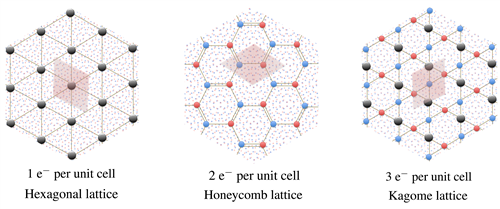Via University of Illinois/ Physics: University of Illinois team finds Wigner crystal—not Mott insulator—in 'magic-angle' graphene  by Siv Schwink
by Siv Schwink
Recently, a team of scientists led by Pablo Jarillo-Herrero at the Massachusetts Institute of Technology (MIT) created a huge stir in the field of condensed matter physics when they showed that two sheets of graphene twisted at specific angles—dubbed “magic-angle” graphene—display two emergent phases of matter not observed in single sheets of graphene. Graphene is a honeycomb lattice of carbon atoms—it’s essentially a one-atom-thick layer of graphite, the dark, flaky material in pencils.
In two articles published online in March 2018 and appearing in the April 5, 2018 issue of the journal Nature, the team reported the twisted bilayer graphene (tBLG) exhibits an unconventional superconducting phase, akin to what is seen in high-temperature superconducting cuprates. This phase is obtained by doping (injecting electrons into) an insulating state, which the MIT group interpreted as an example of Mott insulation. A joint team of scientists at UCSB and Columbia University has reproduces the remarkable MIT results. The discovery holds promise for the eventual development of room-temperature superconductors and a host of other equally groundbreaking applications.
Researchers at the University of Illinois at Urbana-Champaign have recently shown that the insulating behavior reported by the MIT team has been misattributed. Professor Philip Phillips, a noted expert in the physics of Mott insulators, says a careful review of the MIT experimental data by his team revealed that the insulating behavior of the “magic-angle” graphene is not Mott insulation, but something even more profound—a Wigner crystal.
“People have been looking for clear examples of Wigner crystals since Wigner first predicted them in the 1930s,” Phillips asserts. “I think this is even more exciting than if it were a Mott insulator.”
Lead author of the U of I study, graduate student Bikash Padhi, explains, “When one sheet of graphene is twisted on top of another, moiré patterns emerge as a result of the offset in the honeycomb structure. By artificially injecting electrons into these sheets, the MIT group obtained novel phases of matter which can be understood by studying these extra electrons on the bed of this moiré pattern. By increasing the electron density, the MIT group observed an insulating state when 2 and 3 electrons reside in a moiré unit cell. They argued this behavior is an example of Mott physics.”...
...
Thank you to Ron Kita/Don Prohaska for the heads up. - Vlad